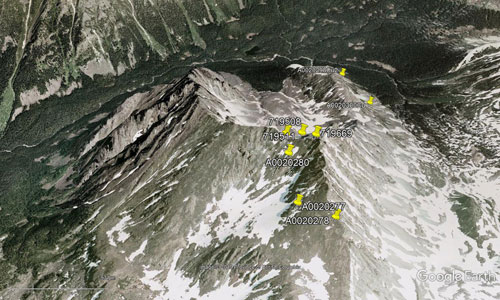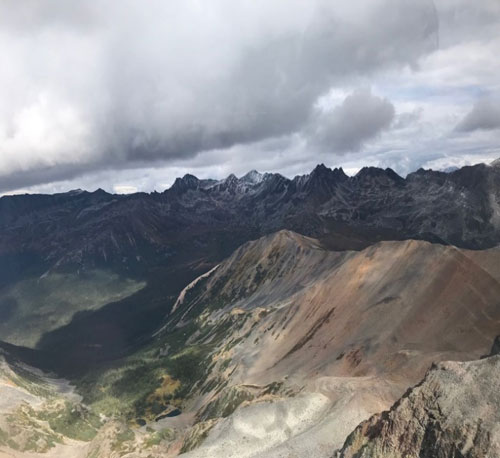April 16th, 2019, Vancouver, Canada – Jaxon Mining Inc. (TSXV: JAX, FSE: OU31, OTC: JXMNF) (“Jaxon” or the “Company”) is pleased to announce the discovery of a large scale copper porphyry system with indications of high grade gold-bearing tourmaline breccia and other sulfide vein mineralization at its 42,244 ha Red Springs project in NW British Columbia. The Red Springs porphyry system is geologically analogous to the Los Bronces – Rio Blanco porphyry in central Chile and involves a unique assemblage of features in terms of origin, structure, associated mineral types, indicative grades and scale, distinguishing it from other porphyry systems already being commercially mined in British Columbia, i.e. Mt. Milligan and Red Chris.
During the 2018 Red Springs field season, Jaxon’s team completed 20 km2 (+/-) of surface geology and structure and alteration mapping; took 700 surface rock samples; conducted 23 km (7 lines) of ground IP and a magnetics survey; and examined 30 thin sections as part of a petrographic study, drilling and assaying 1050 (+/-) metres of core. Completing this work allowed the Company to develop a conceptual geological model which indicates the presence of three major coppery porphyry anomalies: Primary Ridge, “Red Springs” and Razorback. These porphyry targets are associated with two distal showings of polymetallic sulfide vein mineralization and an extensive quartz tourmaline breccia area (Figure 1), as announced in previous news releases dated January 14th, February 4th and 28th, 2019.
Figure 1, outline geology, alteration and mineralization map of the Red Springs project
Razorback Copper Porphyry Target
The Razorback copper porphyry target is directly adjacent (Figure 1) to the tourmaline breccia/vein area at the Backbone and NW Cirques areas, covering an area of approximately 2 km2. Thermal solution events which resulted in the formation of the well-developed tourmaline breccia zone/veins or pipes are related to this large porphyry intrusion complex. Based on the topographic features, it may be a volcano diatreme or caldera (Figure 2).
13 surface outcrop grab/float samples were collected from the Razorback copper porphyry area (Table 1). Copper grades are 0.14% to 1.64% with an average grade of 0.40% with silver and molybdenum credits. Two large boulder tonalite samples with quartz vein and disseminated chalcopyrite and molybdenite collected from the slope of the north end area, A0020298 and A0020300, indicate copper grades at 1.64% and 0.76% and silver grades at 12.51 g/t and 14.31 g/t. The petrographic study on sample 719511 from Razorback shows strong propylitic alteration (Figure 3) and a porphyry veins system (Figure 4).
Figure 2, topographic map of the Razorback copper porphyry target which shows caldera shape intrusive complex
Figure 3, thin section photos of sample 719511 from Razorback porphyry area. Tonalite and albite, clay and/or epidote: subtle after plagioclase and alkali feldspar; chlorite: strong after biotite within the vein-like domain. pl, plagioclast, bt, biotite, qz, quartzite, tn, titanite, py, pyrite, cp, chalcopyrite, mo, molybdenite
Figure 4, left, sample 719511 from Razorback porphyry area, tonalite with chalcopyrite and malachite alterations, showing B-veinlet crossing cut biotite and magnetite veins; right, sample A0020311 from Primary Ridge, monzonite with pyrite, showing strong potassic alteration
Table 1 Sample Summary for the Razorback Copper Porphyry Target
Primary Ridge and “Red Springs” Copper Porphyry Targets
The Primary Ridge and “Red Springs” copper porphyry targets collectively encompass approximately 0.6 km2 (Figure 5) at the northeast corner of the Red Springs project. A potassic alteration zone lies to the north and a quartz-serite-pyrite phyllic alteration zone to the southwest (Figures 1 and 6). Multiple phase intrusive rocks appear in the Primary Ridge area, including granodiorite (Figures 7 and 8) and monzonite (Figure 4). All outcrop rock samples and their petrographic analysis from Primary Ridge show potassic and propylitic alteration.
Nine surface outcrop grab samples were collected from the Primary Ridge copper porphyry target area (Table 2) with copper grades from 0.06% to 0.32% and an average grade of 0.14% with silver credits.
Nine surface outcrop grab samples were collected from the “Red Springs” copper porphyry target area (Table 3) with copper grades from 0.10% to 0.91% and an average grade of 0.26% with silver and gold credits. In addition, seven samples from meta-sediments or hornfels, which may represent the outer zone of the porphyry system, show copper grades from 0.12% to 0.91% with an average grade of 0.30%. It is important to note that a hydrothermal sulfide breccia zone, which is indicative of a porphyry system, has been discovered beneath the talus terrain in the “Red Springs” porphyry target area.
Figure 5, topographic map of Primary Ridge and “Red Springs” copper porphyry targets
Figure 6, argillic and phyllic alteration at Primary Ridge and “Red Springs” copper porphyry targets
Figure 7, granodiorite with chalcopyrite and malachite alteration from Primary Ridge
Figure 8, sample M109 from Primary Ridge, granodiorite, euhedral crystals of plagioclase (pl) and biotite (bt) are immersed within interstitial aggregates of quartz (qz) and alkali feldspar (kf). Plane-polarized transmitted light.
Table 2, Sample Summary for Primary Ridge Copper Porphyry Target
Table 3, Sample Summary for “Red Springs” Copper Porphyry Target
Porphyry Target Highlights
The associations of the tourmaline veins/zones and sulfide polymetallic veins with the mineralogical assemblage of the phyllic alteration are characteristics of the Red Springs porphyry system. The Company’s conceptual geological model indicates the high-grade polymetallic sulfide vein mineralization and well-developed quartz tourmaline breccia veins/zones are all distal to and were generated by the Red Springs porphyry system, located approximately 2-3 km north, identified by the sampling and mapping work completed in 2018 (Figures 1 and 9). The size of the porphyry system is indicated by the presence of a hydrothermal tourmaline breccia mineralization zone (Figures 10 and 11), extending more than one square kilometer in area, a number of strong IP anomalies identified by ground IP studies and other distal polymetallic sulfide vein-type mineralization occurrences. Features of the porphyry system at the Red Springs Project are highlighted below:
- Large and strong argillic, phyllic and potassic alteration areas (Figures 1 and 9)
- Surface outcrop samples show strong chalcopyrite, pyrite, malachite and potassium alteration with up to 1.64% copper grades (Table 1 and Figure 2)
- Well-developed tourmaline alteration and breccia zone – an indicator mineral for a large porphyry copper deposit (Figures 1 and 9 to 11)
- Very strong IP and magnetic anomalies (news release dated December 17th, 2018)
- Compliant with the typical porphyry mineralization model (Figures 9 to 11)
Figure 9, model map of the porphyry intrusive and zoning alteration at the Red Springs project
Figure 10, hydrothermal breccia pipe model in porphyry deposit
Figure 11, modified porphyry mineralization model at the Red Springs project
John King Burns, Jaxon’s CEO commented, “Numerous genetic models for worldwide porphyry deposits are available for reference. Porphyry alteration zones, different sub-epithermal polymetallic sulfide vein mineralization, chimney-breccia, furnace (intrusive) and most importantly, the existence of a hydrothermal breccia system are all major indicators of a typical porphyry system. Our team has studied numerous existing porphyry deposit models and carefully examined porphyry models with associated tourmaline breccia zones that have occurred in South America. We have used this information to create a conceptual geological model which indicates a large porphyry system associated with an extensive tourmaline breccia complex, distal sulfide polymetallic occurrences and well-developed porphyry style alterations. All of the mineral occurrences and alterations at Red Springs are associated with events generated by the porphyry anomalies. The information we used to derive this model and describe these discoveries was developed during the 2018 exploration season. The 3D conceptual geological model indicates the tourmaline breccia zone extends to the Razorback porphyry target. Preparations for the 2019 season are being planned to conduct soil sampling and detailed surface geological mapping of the structures and alterations at the Primary Ridge porphyry targets. Rock sampling is being planned, as well as extending the ground IP survey programs to cover the Razorback porphyry target. We are also preparing to complete three to five (1000 m) diamond drill holes to test the strongest IP and soil geochemistry anomalies before the end of the 2019 work season. Given the scope and scale of the opportunity, we are in discussions with a number of parties who may join us; to allow for a more rapid completion and to possibly expand the proposed work programs.”
Sample Preparation and Analyses
Prospecting samples were collected in the field by experienced, professional prospectors and geological staff who selected hand samples from outcrop, chip samples, boulder and talus debris samples suitable for slabbing by rock saw. The samples were numbered, described and located in the field for follow-up. Numbered rock sample tags were placed inside each bag and securely closed for transport to the Company’s secure cold storage locked facility in Smithers, B.C. Representative sample slabs were cut from large specimens and halved rock samples so that portions of select samples could be saved for the Company’s rock library, descriptive purposes and petrographic study. MS Analytical of Langley B.C. received the Rice Bag shipments from Smithers and then prepared the samples by crushing, grinding and pulverizing to a pulp with barren material washing between each sample at the crush and pulverizing stages. Then 20 g of pulp was used for the (IMS-117 code) ultra-trace level ICP/MS AR digestion method, and four acid 0.2 g ore grade ICP – AES method (ICP-240) and for the overlimit gold the FAS-415 method of 30 g fusion Gravimetric method was used to report gold ASSAYS. Overlimit silver is determined by Fire ASSAY 415 method. Laboratory standards and QA/QC are monitored by the Company.
All rock thin sections were prepared by Vancouver Petrographics Ltd. and described by Fabrizio Colombo, Ph.D., P.Geo., Principal Consultant with Ultra Petrography and Geoscience Inc.
Qualified Person
Yingting (Tony) Guo, P.Geo., COO of Jaxon Mining Inc., a Qualified Person as defined by National Instrument 43-101, has reviewed and prepared the scientific and technical information and verified the data supporting such scientific and technical information contained in this news release.
Hazelton Option Renewal
On April 5, 2019, the Company renewed one of its options at its Hazelton property. In connection with the renewal, the Company made a payment of $5,000 and issued 50,000 shares.
About Jaxon Mining Inc.
Jaxon is a precious and base metals exploration company with a regional focus on Western Canada. The Company is currently focused on advancing its Red Springs project in north-central British Columbia.
ON BEHALF OF THE BOARD OF DIRECTORS
JAXON MINING INC.
“John King Burns”
John King Burns, Chairman
For Capital Markets for Jaxon Mining Inc., call 778-938-4459, for Investor Relations 604-558-2630 or 1-888-280-8128 and for Corporate enquiries 604-398-5394.














